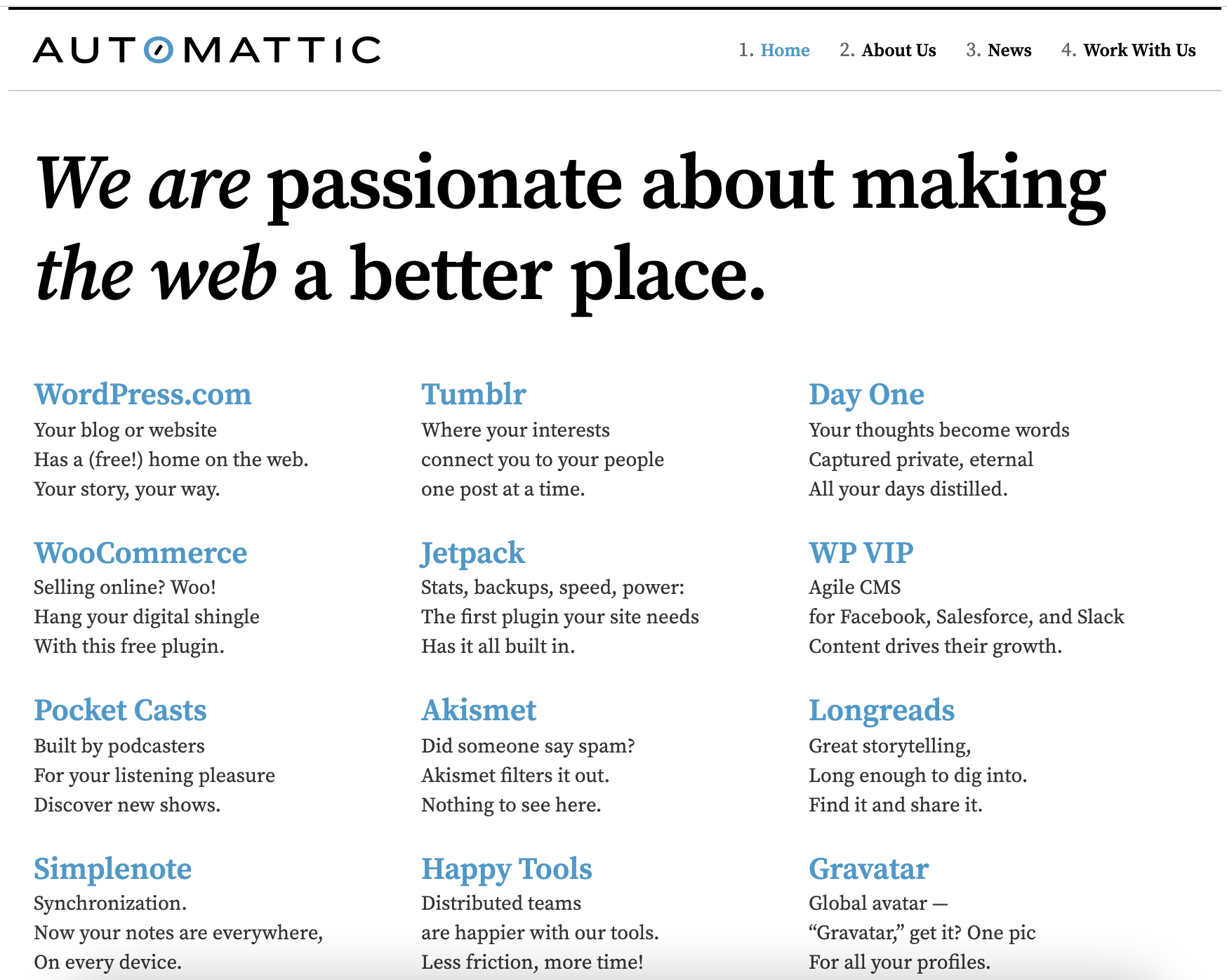It’s impossible to talk about Automattic without talking about remote work. The company is a role model and innovator in this area: It has been entirely remote since 2005, and at 1,700 employees, it has helped prove that a remote workplace culture can succeed at scale.
But “remote” has taken on a different meaning than it denoted two years ago. Since COVID-19 began, companies that never planned on working remotely have moved millions of employees online. Zoom’s video meeting minutes grew 30x as employers made a mad dash to replicate physical offices within virtual meeting rooms. Initial studies have shown that productivity declined as a result.
Perhaps that’s why Automattic rejects the word “remote” entirely. Instead, its leaders use words like “distributed” and “asynchronous.” There is no online analogue to an office; indeed, Automattic doesn’t even require that employees know what each other’s faces look like.
At its most basic level, Automattic’s model isn’t about remote work at all. Instead, it’s about how the company is structured, from its management, to its communication style, right down to its hiring process.
No more meetings
I got a peek into just how different Automattic is from ordinary companies while scheduling one of the interviews for this article. Usually, finding a good time with interviewees involves hunting through a packed schedule for the few morsels of time available. A busy executive might have two or three openings during a week with every other slot filled.
Instead, when Monica Ohara, chief marketing officer of WordPress.com, sent me her Calendly link, I saw a wide open schedule. Ohara, by all appearances, wasn’t doing much work. When I asked about it, she laughed.
“It’s the thing I think is really broken with normal office work,” she said. “Your meeting calendar was a badge of honor and having so many meetings meant you were so important. That’s not a paradigm here.”
Instead, most communication is written and asynchronous — meaning that it can be addressed anytime during the work day.
A CMS for a CMS company
Automattic’s replacement for meetings and most office collaboration is P2, a modification of WordPress that it announced in August 2020 at the height of the pandemic and offers as a paid service.
WordPress.com launches new P2 to take on internal communication tools
A P2 post looks more or less like a blog post, with threaded discussions, the ability to follow replies and a Like button. Whenever employees want to discuss anything with distant colleagues — for instance, a coder in the United States who wants to share something with a designer in South Africa who’s asleep at the time — they can write about it on the company’s P2 instance. Anyone else who is potentially interested can find the same post with a search or through various discovery features built into the platform.

Documentation is the order of the day, up to and including information that would be hidden at other companies.
“You need to be extremely transparent. Matt [Mullenweg, Automattic’s founder and CEO] posts what he’s working on. I post what I’m working on,” said Mark Davies, Automattic’s CFO, who previously worked at smart home platform Vivint, which operated as a much more traditional company. “When I came here for the first time, I had a board meeting, and I said, ‘Let’s get to work.’ They said, ‘No way, you need to post the board deck and what the decisions were.’ I said, ‘You’ve got to be kidding me!.’”
P2 isn’t the only communication method at Automattic — the company also uses software like Slack and Jira. Nonetheless, all the company’s tools share a common thread of asynchronicity: You have colleagues across the world, so don’t expect an immediate reply.
“You’d think that things could move slower here, but they really don’t. I think in offices, there’s also this perception that you have to be in-person. People are saving things up for their one-on-one or meeting when they could have sent an email,” said Ohara. “Here, I’ll often wake up and find out there’s lots happening in Europe that I need to catch up on versus us having to wait a week or two to get a conference room.”
Documenting everything and allowing employees to consume only what they need saves time. “I spend a lot more time communicating and a lot less time listening and sitting in reviews,” said Davies.
It may cost more time upfront, but he also believes that the company has been able to grow faster because it’s distributed. During his two years at Automattic as CFO, it grew from around 1,000 to over 1,700 employees.
“We’re growing quicker with fewer issues because we are distributed versus being together. We don’t have to go to Asia and open an office, or go to Europe and open an office. We’re there already, and as we grow, it naturally absorbs the business,” he said.
Hiring an employee sight unseen
As Silicon Valley has strived, and mostly failed, to increase diversity, many critics have wondered whether “culture fit” could be responsible. Companies claim they want diverse employees, but then they use an amorphous, chameleonic idea of culture to reject anyone that actually is diverse. In-person interviews, far from building better relationships with potential employees, can actually surface and accentuate differences, diminishing diversity in the hiring pipeline.
Remote interviews, of course, mostly follow the same format, with a Zoom room replacing the interviewer’s table.
Automattic does conduct video interviews, but it also offers different options to candidates who want it. One of these is a purely written interview, where the candidate never needs to reveal their face or voice to anyone in the hiring process.
“You normally think you’ve got to talk to them; see them on video. With text only, you remove all this bias and focus on the content of what they’re saying, and also test for a style of communication that’s really important in a distributed team,” says Ohara.
Automattic likes to tout its global hiring policy and that it has employees in 89 countries. Ohara points out that looking for employees globally also makes it easier to reach true diversity.
“In Silicon Valley, everyone is competing for the same people that would add diversity to your pool. Which is great for those people, but what about all the others who don’t have those opportunities because of where they were born or live? For me, I was born in the Philippines and if I hadn’t had the luck to move here, I’d be living a different life,” she said.
The only requirement for all employees is being able to communicate in English, which needs to be good enough to get ideas across, but not perfect.
Of course, some people aren’t good at written communication, which is a flaw in Automattic’s otherwise wide hiring funnel. In addition, Paul Maiorana, the CEO of Automattic subsidiary WooCommerce, notes that comfort with acting publicly could also be a problem for some employees.
“Tactically, you need to work in public here. I’ll put an idea out on P2, and all 1,500 people in the company have access to see that and can tell me it’s a terrible idea,” he says. “Folks who have an outsized ego or are more sensitive to working in public would struggle in a culture like this.”
From CEO to CEOs
Around 2018, Automattic began splitting off its business verticals into separate businesses with their own management teams. WordPress.com, WordPress VIP, Jetpack, WooCommerce and several others are now distinct business units under the Automattic umbrella.

From the top down, the setup looks similar to larger holding companies like Alphabet and Berkshire Hathaway, but Automattic’s businesses have a common core that those conglomerates don’t.
“Alphabet might have businesses that are so independent, they share little product DNA. Here at Automattic, there’s a lot shared between these businesses. We’re highly independent, but collaborative,” says Nick Gernert, the CEO of WordPress VIP. Gernert’s unit, for instance, runs enterprise accounts for WooCommerce.
The structure also works well because Mullenweg is more of a big-picture thinker, with his focus split between Automattic and the open source WordPress project.
“Matt likes to think 10, 20, 30 years into the future, create those points on the horizon, but then look to folks like myself to drive toward those points in the business,” says Gernert.
Setting up separate business units also helped the company grow faster.
“It was a huge unlock to take something like VIP and let it be its own business with its own way of scaling and hiring,” said Toni Schneider, the former CEO of Automattic and a current board member. “That business has a few hundred high-end enterprise customers, and WordPress has millions of customers. They’re very different businesses with the same underlying software.”

In general, Automattic has never been the kind of company that sets hard expectations for employees or tries to exert tight control over them. Splitting out multiple business units is just one more manifestation of that relaxed attitude.
“The culture here is, if you see something that should get done in service to our customers, that’s what motivates people. It’s not just about building a gigantic business; it’s about helping people and driving people forward,” says Maiorana.
“Everyone is interested in helping our customers, helping to secure the future of the platform. It’s one of those things that’s a little hard to see from the outside, how we operate and how it comes from that intrinsic motivation.”
Changing the world by changing publishing
Conscious of how fast the pandemic was pushing companies online, Mullenweg introduced a new model last year: The five levels of autonomy, a pyramid similar to Maslow’s hierarchy of needs. Higher levels of the pyramid require more of the practices described above, as well as quality-of-life improvements around home offices, for example.
Mullenweg wrote:
You tap into the global talent pool, the 99% of the world’s population and intelligence that doesn’t live near one of your legacy physical office locations. Employee retention goes way up, and you invest more in training and coaching. Most employees have home-office setups that would make office workers green with envy. You have a rich social life with people you choose.
Real-time meetings are respected and taken seriously, almost always have agendas and pre-work or post-work. If you get good at baton passes, work will follow the sun 24/7 around the world. Your organization is truly inclusive, because standards are objective and give people agency to accomplish their work their way.
As Mullenweg puts it, most companies are still only at level two — recreating the office online, without any of the improvements or benefits that should come from working online. For companies at that level, going back to the office may make more sense.
That is, if their employees let them do it. Studies this year have shown that a majority of employees in the United States now prefer at least a hybrid work arrangement, with some remote work, while around a third threaten to switch jobs if forced to return to the office.
In the end, companies that want to retain the best workers may be forced to learn from Automattic’s model — one that the company is happy to share with the rest of the world.
“There was definitely a moment when we thought, ‘Wow, WordPress was awesome, but we’re also building the distributed model, and in the truly long run, that might be our bigger contribution to the world,’” says Schneider.
For a company that has constantly fought against conventional received wisdom, how it approaches hiring and work is just another sign that Automattic has somehow managed to scry the future before others — sometimes more than a decade ahead.
WordPress continues to be the open sourced foundation for the company’s success, and if it can level up in e-commerce and social, it may yet supplant the internet giants as the most interesting platform to build upon in the 2020s.
Nothing was automatic, but then again, it’s the manual handling that has made Automattic a company to watch.
Automattic TC-1 Table of Contents
- Introduction
- Part 1: Origin story
- Part 2: Open source development
- Part 3: Acquisitions and future strategy
- Part 4: Remote work culture
Also check out other TC-1s on TechCrunch+.































Comment